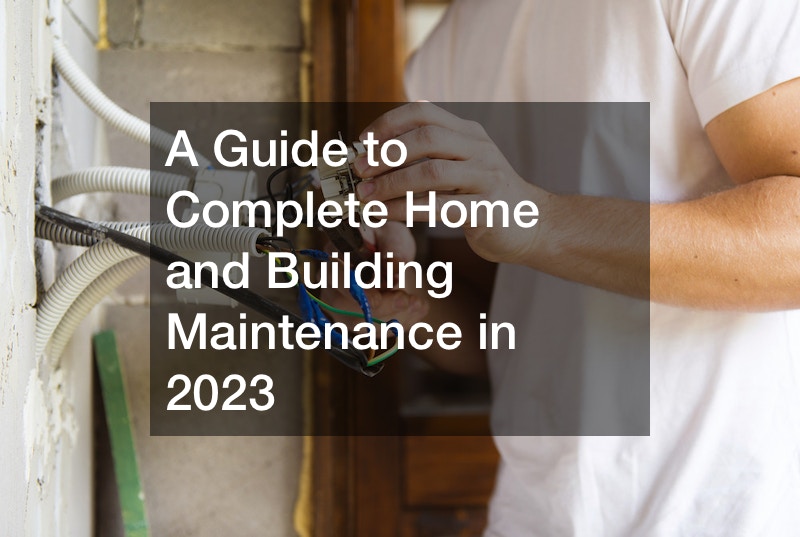
Regular maintenance ensures a facility’s functionality and prevents unexpected expenses, among other benefits. However, a lot is involved, and it can sometimes get confusing. Don’t worry, though. Here’s a guide to complete home and building maintenance.
1. Have All the Right Equipment

Everyone involved in the building maintenance process should always use a complete home and building maintenance checklist to ensure they have the necessary tools to complete the job. These individuals include building custodians responsible for cleaning the building; handypersons who act as the light servicemen who’ll do stuff like paint jobs as well as simple repair jobs; Industrial maintenance specialists who examine, maintain, and fix heavy machinery; landscapers who design and maintain outside landscapes; and facility managers who oversee the maintenance of commercial buildings. Custodians use various cleaning supplies to clean interior and exterior surfaces and tools.
Their tools include vacuum cleaners, cleaning chemicals like bleach ammonia, degreasers, brooms and mops for floor cleaning, and window washing tools like scrubbers, squeegees, and extension handles. They also use specialized tools for mowing lawns, trimming trees, and other landscaping tasks. The most common tools are pushing and riding lawnmowers to cut grass, trimmers to trim plants, aerators to increase irrigation, and clippers to trim hedges and trees.
You also need power tools for maintenance and repair, which help you complete tasks with minimal effort. Key tools include power drills, orbital sanders, circular saws, and impact wrenches. Maintenance professionals like electricians must have electrical tools like wire and cable strippers to remove rubber coating from wires, multimeters to test circuit functionality, and crimpers for minor electrical repairs. Some professionals may require a trailer dealer to lend them a trailer to carry equipment, as it can get bulky. Alternatively, they can buy a trailer at a yard, offering a utility trailer for sale.
2. Have Safety Measures in Place
Hazard prevention and safety are among the key areas to consider when taking up any physical job. A complete home and building maintenance professional is mindful of safety when handling tools and materials at the workplace and exercises caution during jobs. Start by following the proper dress code before you start working.
Wear the relevant protective gear, including gloves, a helmet, goggles, ear muffs, aprons, overalls, and dust masks, depending on where you work. Ensure all the protective gear you’re wearing is procured from reputable brands. For cleaning specialized buildings like hospitals, hire hospital waste pickup services to help dispose of dangerous waste.
Always verify that all your tools are working right. Part of maintaining safety is ensuring no malfunctioning machine goes into your toolbox. Hazards and accidents happen when workers try to use such machines, and they backfire, causing all sorts of trouble. As a routine, tools should be regularly checked, repaired, and serviced to keep them well-maintained for next time use. Plan the work schedule to ensure your workflows and tools are always in working order.
The last way to ensure you’re safe during work is to use reliable assistance. Don’t try to do it alone if it’s a two-person job. Otherwise, you can potentially cause accidents at the workplace. Also, avoid shortcuts. If there are standards and procedures to be followed in handling a maintenance job, follow all the steps without shortcuts to avoid hazards and injuries.
3. Be Organized and Efficient

All measures and everything you do towards streamlining the maintenance activities of the building can be considered as organizing the department. There are advantages to being organized, and one of them is efficiency. Efficiency in the building maintenance process can be translated as increased productivity. When you’re organized, there’s more output attained per unit of time and labor, less time wasted, increased chance of meeting deadlines, and work is simplified. Dock levelers are platforms that building owners can use to protect their buildings while loading and unloading materials. Vehicles sometimes suffer bumper damage during loading and unloading times. You can hire bumper repair companies to fix this.
Create a complete home and building maintenance schedule by dividing activities into preventative and curative maintenance. Preventive maintenance activities are those you do to prolong a building’s lifetime. It includes all maintenance activities carried out for asset upkeep. If you consider this, preventive maintenance duties are especially crucial since they help find and resolve potential structural problems before they result in significant harm. Building owners, homeowners, and managers can proactively address problems like wear and tear, corrosion, and other degradation by conducting routine inspections and maintenance.
Corrective maintenance refers to the activities undertaken to restore a building’s functionality when something breaks down. Preventive measures are good. They minimize a building’s chances of decay or damage to a building, but eventually, it still happens. For this reason, it’s essential to have in place a clearly defined maintenance strategy for a complete home and building maintenance schedule. It’s impossible to eliminate the possibility of issues arising completely. With such measures, you can prevent minor issues from escalating into larger and more costly problems.
4. Compile a List of Necessary Services
A complete home and building maintenance schedule should include a checklist of services required. Generally, facility maintenance checklists look largely the same. Most buildings and houses have similar features, fixtures, and utilities. Creating a building maintenance checklist requires in-depth knowledge of a building’s systems and main parts. Here’s how you can go about it. The first step is identifying the important systems and components that demand routine upkeep. HVAC systems, electrical connections and systems, plumbing systems, roofing, and specific structural components. Next, determine the necessary maintenance activities required for each system or component. Then, make a timetable based on the maintenance activities.
There should also be checks guiding the servicing of individual systems. For instance, for an HVAC system and equipment maintenance, the service member should check the thermostat, clean the drains, inspect refrigerant levels, visually inspect the wires, clean coils, replace the air filter, and check to see if the airflow from the HVAC unit is all right. For fire equipment maintenance, check the expiry date on all fire extinguishers and whether smoke detector batteries still work. Ensure extinguishers and signs are correctly placed, exit doors aren’t obstructed, and the sprinklers work. Building equipment maintenance depends on the kind of equipment you have.
Before the start of the actual season, finish seasonal-related maintenance tasks. Check for icicles and ice dams in the winter since they can harm the roof and gutters. Make sure the heating system is functioning properly as well. Look for winter-related damage to the building’s exterior in the spring. Examine the roof, clean the gutters, and check the windows and doors for leaks.
Call a pump service company to service your systems. Focus on the HVAC system in the summer to make sure it’s prepared for the heat. Replace air filters and inspect the cooling system. Prepare for the cooler months in the fall. Examine the heating system and ensure all windows and doors are securely sealed.
5. Invest in Communication Technology

Communication problems are common for facilities’ maintenance departments because of the complexity of their work. The need to oversee several teams and ensure timely task completion can prevent owners from paying attention to crucial responsibilities. Communication within these departments can be managed with the aid of technology.
Information can be easily accessed using various cloud storage platforms. By using these tools, facility maintenance leaders can see quantifiable improvements in communication within their departments, leading to increased productivity and creating an environment for happier clients and staff. Audio visual companies are instrumental in providing these services.
Mobile gadgets like smartphones and tablets are gaining popularity due to their convenience and speedy information dissemination capabilities. Managing service requests projects and complete home and building maintenance schedule monitoring can all be enhanced using computerized maintenance management software (CMMS). This is a potent and effective communication tool. CMMS allows team members to read work orders, ask questions, submit photographs, and comment on them.
Landlords and property managers should utilize a property management app to track repair requests efficiently. The software should be able to immediately respond to maintenance requests in addition to tracking them, allocating maintenance contractors, and guaranteeing requests are answered promptly. With a property management tool, a landlord can do much more. They can plan preventative maintenance tasks, carry out routine seasonal inspections, and keep a network of repair service providers.
6. Hire Professionals
Hiring professionals is the most effective way to achieve optimal building maintenance. This has advantages, including the fact that a building maintenance company acts as your tenants’ initial point of contact. You don’t need to run over to the property to handle issues constantly. Instead, you can direct any complaints or issues through your property maintenance manager. The property manager can take the responsibility to schedule service providers and address potential issues. The same should apply should the need to move arise. Hire local moving companies to provide that service for you.
Professional building maintenance companies ensure you don’t encounter troublesome legal issues or prospective litigation. They are familiar with the local building codes and understand how to handle every situation to keep conflicts and issues minimal. If your property manager can handle the legal issues, you may save money by avoiding a protracted court battle. A skilled building maintenance firm knows how to deal with renters and can immediately identify problematic ones, those who aren’t taking good care of your property. Happy tenants are a result of a skilled building maintenance company.
A good building maintenance firm can keep long-term renters who renew their leases yearly. There’s a greater likelihood that your tenants won’t want to renew their lease if your property needs more upkeep. The possibility of lost rental income arises when tenants fail to renew their leases. The purpose of hiring a maintenance company is to simplify your life. Less worry for you as the owner of the building and less time spent maintaining the properties. These are some of the advantages you receive from using their services.
7. Stay on Schedule and Budget
Staying on schedule and within budget are two things that will ensure your building is well-maintained and that it doesn’t bankrupt you in the process. People are among the issues you’ll need to consider to develop a complete home and building maintenance schedule. When discussing people, we discuss skill sets such as welders, mechanics, plumbers, and others, people with a specific skill set. Determine how many people you need to complete the task as you plan it out. Another component is your estimation of how long you’ll need those people. The time is the scheduling component here. The objective is to meet production needs using the available labor resources.
The other element of planning a work activity is information. This can be in various forms, such as disassembly, torque specs, clearances, safety elements, permits, and experience. It’s crucial to capture this information and maintain accuracy for future work. Tools, equipment, and materials are the final consideration. These include manlifts, cranes, and forklifts. A single axis manufacturing table can be included in an HVAC maintenance list of tools. Also, ensure your tools are in good working condition, and hire a crane repair company to inspect and service your cranes regularly.
To create a budget for building maintenance, follow these steps: include maintenance for mechanical and electrical equipment, as well as larger capital expenses like HVAC equipment. Furniture also lasts 10 to 15 years, but companies may need to adjust to changes in style or working arrangements. Consider factors like equipment nearing the end of its life cycle, upcoming renovations, mergers, or hiring increases. Reassess the budget every six months to ensure a functioning office for the company’s success.
A successful landlord or building owner maintains their rental properties well. A complete home and building maintenance schedule keeps the homes’ fixtures, installations, and appliances in good working order, which lowers repair costs and increases rental income profits. With a complete home and building maintenance schedule, you can avoid scenarios where you’re losing your building or putting your life and tenants’ lives in danger. It also protects you from litigation from building negligence. While this guide doesn’t claim to be comprehensive, it should at least set you on a journey to complete home and building maintenance in 2023 and beyond. Proper building maintenance is at the core of high tenant occupancy; the converse is also true. Poorly maintained buildings are rarely fully occupied, and now we know why.



